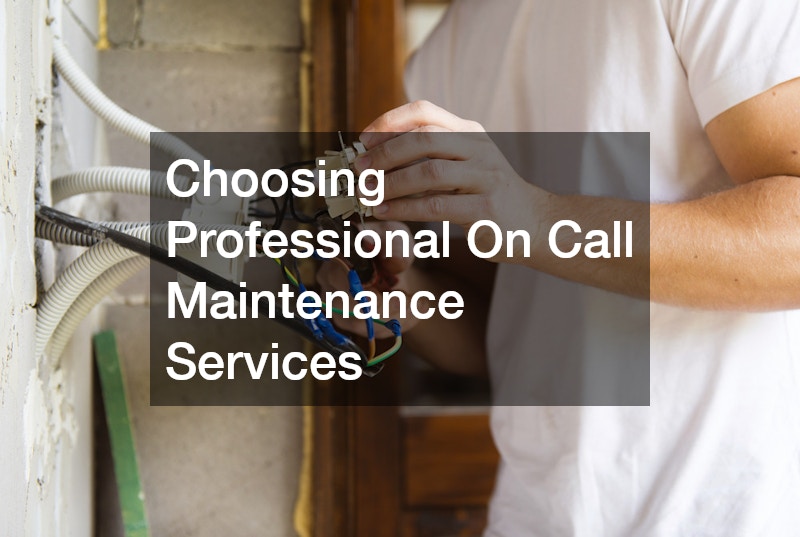In today’s competitive and fast-moving business environment, maintaining your facility efficiently is essential to ensuring seamless operations. Professional on-call maintenance services have emerged as a smart and strategic option for many organizations. Rather than relying solely on full-time maintenance staff, businesses are turning to these services to address urgent repairs, specialized tasks, and seasonal maintenance needs. This article explores what on-call maintenance services entail, how to select the right provider, and why this approach may benefit your business in the long run.
What are On-Call Maintenance Services?

Definition and Scope
On-call maintenance services involve contracting skilled professionals who are available to respond to maintenance needs as they arise. This model allows businesses to access support without committing to full-time employment costs. These services can be especially useful for specialized tasks such as siding repair, roof inspections, or even mold removal from walls, which require expertise and timely execution.
Types of Services Offered
The scope of services typically includes a wide array of maintenance and repair functions. Common offerings are electrical and HVAC servicing, plumbing repairs, tree removal, and emergency restoration. More specialized services may include hydro jetting to clear blocked sewer lines, vinyl siding installation for property upgrades, and addressing water damage from leaks or flooding. Additionally, roofers and plumbing companies often provide on call options to handle urgent or seasonal tasks.
Benefits of On Call Services
On call services provide businesses with flexibility and cost efficiency. Companies pay only for the services they need, helping manage budgets more effectively. Another benefit is access to diverse expertise without the logistical burden of hiring and training. For example, a water damage company can be brought in immediately after flooding to prevent further structural issues or contamination. Having on call specialists ensures a faster response to minimize downtime and repair costs.
Key Industries Utilizing These Services
Industries such as healthcare, hospitality, manufacturing, and retail frequently rely on on call maintenance. These sectors often face unique challenges like ensuring indoor air quality, maintaining clean drinking water systems, or handling high-foot traffic damage to siding or flooring. Professional maintenance providers can quickly respond to these needs, supporting business continuity and compliance with safety regulations.
When to Consider On Call Maintenance Services
Organizations might consider this service model when they encounter fluctuating maintenance demands or when existing staff lack the expertise for specialized work. For instance, facilities facing recurring leaks or damaged siding may benefit from contacting local roof repairs specialists or siding repair contractors on an as-needed basis. Companies expanding into new facilities also find this model helpful for handling unexpected infrastructure issues during transition periods.
How to Evaluate Service Providers?
Checking Credentials and Experience
Choosing the right provider begins with verifying their qualifications and work history. Make sure the technicians are certified and experienced in specific services, such as vinyl siding installation, hydro jetting, or mold removal from walls. Reviewing case studies or portfolios can also provide insight into the provider’s capabilities.
Understanding Service Agreements
Carefully review the terms of service agreements. Look for details regarding response times, service limitations, and any included guarantees. A trustworthy water damage company, for example, should outline procedures for emergency response and follow-up inspections.
Availability and Response Times
Response time is a critical factor in evaluating providers. Whether dealing with burst pipes, tree damage, or emergency roof leaks, fast service can prevent extensive property damage and business disruption. Always ask providers about their average response time and emergency call availability.
Cost and Value Assessment
Compare pricing structures among providers to determine value for money. Some may offer flat rates for basic services like plumbing or siding repair, while others charge by the hour. Balance cost considerations with service quality to avoid sacrificing reliability for a lower price.
Reading Customer Reviews and Testimonials
Online reviews and client testimonials are valuable resources for assessing service quality. Look for consistent positive feedback on services such as vinyl siding installation, local roof repairs, and plumbing response. Negative reviews, particularly regarding timeliness or professionalism, should raise concerns.
What are the Costs Involved?

Fee Structures and Pricing Models
On call maintenance providers use various pricing models, including flat-rate fees for specific services or hourly billing. For instance, roofers might charge differently for a patch-up job versus a more comprehensive replacement. It’s essential to understand which model works best for your business needs.
Hidden Costs to Watch For
Be aware of hidden costs such as after-hours fees, travel expenses, or charges for equipment rentals. Services like hydro jetting or emergency mold removal can involve specialized tools and chemicals, which may not be included in the base fee.
Comparison of Flat Rate vs. Hourly Rate
While flat rates offer predictability, hourly rates may be more cost-effective for simple tasks. However, complex repairs—such as dealing with extensive water damage or emergency plumbing—can quickly become costly if billed by the hour. Understanding the scope of the issue can help determine the most economical approach.
Assessing Cost vs. Benefits
Evaluate the long-term value of professional maintenance. Preventing structural damage with timely tree removal or avoiding costly remediation with early mold detection adds significant value. Investing in high-quality services can reduce the likelihood of future breakdowns and emergencies.
Budgeting for Maintenance Costs
Include on call maintenance in your facility’s annual budget planning. Allocate funds for seasonal tasks such as vinyl siding installation, HVAC servicing, and plumbing inspections. This proactive approach can help prevent financial strain from unexpected issues.
What Services Are Typically Included?
Emergency Repairs
Emergency services cover immediate needs such as broken water lines, roof leaks, or electrical faults. Fast response is critical to minimizing damage and ensuring occupant safety.
Routine Maintenance Tasks
On call services may also include recurring maintenance like filter changes, system checks, and minor repairs. This prevents issues from escalating and keeps operations running smoothly.
Equipment and Facility Inspections
Providers often offer scheduled inspections to assess infrastructure health. These may include examining roof structures, siding conditions, and water delivery systems to ensure everything meets safety standards.
Safety and Compliance Checks
Ensuring that your building complies with safety codes and regulations is vital. This includes regular inspections, drinking water testing, and maintenance of fire suppression systems.
Asset Management and Record Keeping
Detailed reports and maintenance logs help track service history, costs, and compliance. Accurate records support insurance claims and regulatory audits, especially following major interventions such as mold removal or siding upgrades.
How to Customize Services for Your Needs?
Assessing Specific Maintenance Needs
Begin by evaluating your facility’s unique needs. Does your building have older roofing, high tree density, or persistent plumbing issues? This assessment will help you prioritize services like local roof repairs or hydro jetting.
Tailoring Service Packages
Many providers offer customizable packages. If your facility frequently experiences exterior wear, for example, prioritize siding repair and tree removal services in your plan.
Negotiating Terms and Conditions
Work with providers to set clear expectations on service scope, response times, and billing. Providers who specialize in niche services, such as water damage restoration or mold removal from walls, may offer flexible terms for frequent clients.
Collaborative Planning with Providers
Collaboration fosters a stronger service relationship. Share your maintenance calendar and building layouts with your service providers so they can anticipate needs and prepare accordingly.
Scalability and Flexibility Options
Choose a provider who can scale services with your growth. For instance, a plumbing company that supports multiple locations or a roofer who can handle commercial as well as residential structures offers long-term partnership potential.
What Are the Benefits of On Call vs. Full-Time Staff?

Cost-Effectiveness
Hiring full-time maintenance staff involves salaries, benefits, and ongoing training costs. On call services eliminate these expenses, making them a more affordable option for many businesses.
Access to Specialized Skills
On call providers bring specialized knowledge not always available in-house. From advanced plumbing diagnostics to safe tree removal and vinyl siding installation, these skills are crucial for complex projects.
Flexibility in Service Delivery
You can scale services up or down depending on business needs or seasons. This flexibility is especially useful in managing weather-related issues like roof leaks or tree damage.
Reduced Overhead and Administrative Burden
Working with external professionals reduces your administrative workload, allowing internal teams to focus on core responsibilities rather than maintenance coordination.
Improved Risk Management
Quick access to professional help minimizes downtime and liability. For example, prompt mold removal prevents health hazards, while immediate roof repairs protect interior assets from water damage.
What Legal and Compliance Considerations Are There?
Liability and Insurance Requirements
Ensure your service provider carries appropriate liability insurance. This protects your business from claims in case of accidents or incomplete work.
Contractual Obligations
All agreements should clearly define scope, timelines, and performance expectations. Clauses related to late service or unsatisfactory work must be outlined in writing.
Regulatory Compliance Standards
Maintenance services must adhere to local and federal regulations. This includes compliance with building codes, health standards, and environmental laws.
Data Security and Privacy Concerns
With modern systems like CMMS in place, ensure that sensitive building and operational data are securely managed and stored.
Environmental Impact and Sustainability
Partner with providers that support sustainability. Look for eco-friendly solutions in mold remediation, tree removal, and drinking water systems.
How to Measure the Performance of Maintenance Services?
Key Performance Indicators (KPIs)
Track measurable outcomes such as average response time, repair completion rates, and cost per intervention to gauge provider performance.
Service Level Agreements (SLAs)
SLAs outline service expectations and penalties for failure to meet them. These are essential for accountability and continuous improvement.
Regular Feedback and Reporting
Ongoing reporting helps you track trends, identify recurring issues, and optimize your maintenance strategy. Include feedback loops to encourage provider responsiveness.
Client Satisfaction Surveys
Surveys are a valuable tool to measure satisfaction and uncover areas needing improvement. Use these insights to adjust scope or expectations as needed.
Continuous Improvement Strategies
Encourage providers to use performance data to refine their services. A proactive approach ensures that your facility benefits from the most efficient and modern maintenance practices.
What Technologies Support On Call Maintenance Services?

Computerized Maintenance Management Systems (CMMS)
These systems streamline task tracking, documentation, and communication between clients and providers, making service delivery more efficient.
Mobile and IoT Solutions
Technologies like remote sensors can alert providers to issues like leaks or equipment failure, enabling immediate response and reducing damage.
Predictive Maintenance Tools
By analyzing historical data and trends, predictive tools can help prevent failures before they occur, saving both time and money.
Remote Monitoring and Diagnostics
This technology allows providers to diagnose problems without needing to be onsite immediately, particularly helpful in managing systems like HVAC or plumbing.
Technology Integration and Data Management
Ensure all systems integrate well with your internal operations for seamless data sharing and effective decision-making.
How to Transition to an On Call Maintenance Strategy?
Developing a Transition Plan
Start with a roadmap that outlines what services will be outsourced and which will remain internal. This helps manage expectations and ensures a smooth handover.
Phasing Out Internal Maintenance Staff
Offer support and redeployment options for internal teams affected by the transition. Transparent communication is key to maintaining morale and cooperation.
Training and Support for Internal Teams
Equip remaining staff to work alongside external providers effectively. This might involve training in technology use or revised safety protocols.
Evaluating Pilot Programs
Test the new approach with a pilot program, focusing on high-priority services like local roof repairs or plumbing emergencies, to measure effectiveness.
Managing Change and Stakeholder Expectations
Maintain open communication with stakeholders throughout the transition. Highlight cost savings, performance benefits, and long-term advantages.
Closing Thoughts
Choosing professional on call maintenance services is a strategic decision that can enhance your facility’s performance, reduce costs, and ensure compliance with safety and environmental standards. By carefully evaluating providers, understanding cost structures, and leveraging modern technology, businesses can access high-quality services ranging from siding repair to mold removal from walls. Whether it’s coordinating with roofers for storm damage, hiring plumbing companies for hydro jetting, or engaging a water damage company after a flood, on call services provide a practical and efficient way to manage maintenance. With a customized and scalable approach, your organization can enjoy increased reliability and peace of mind.



